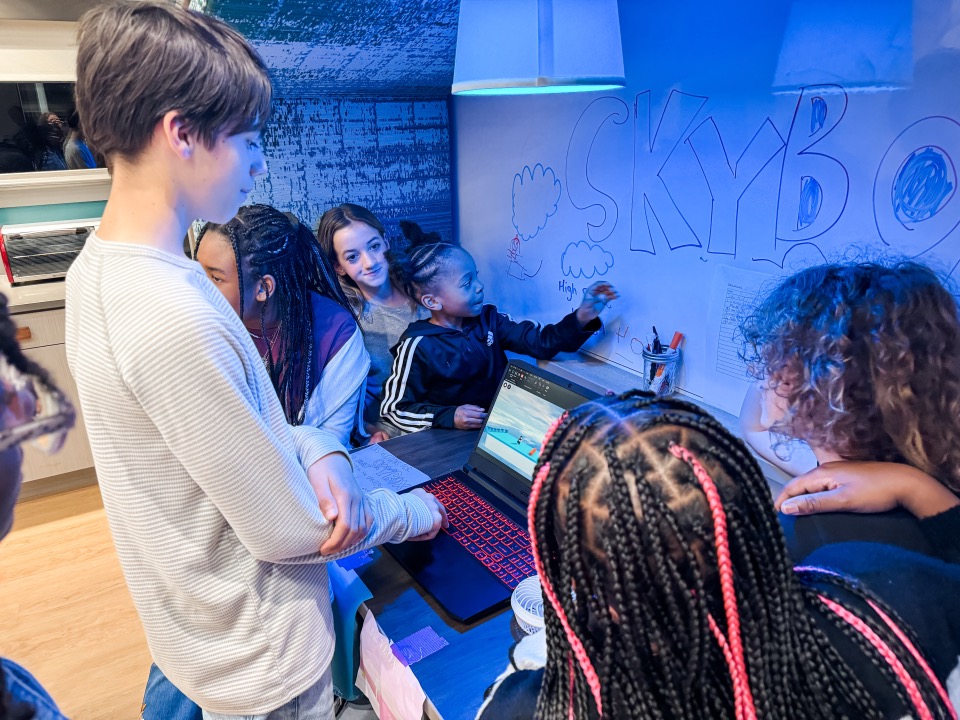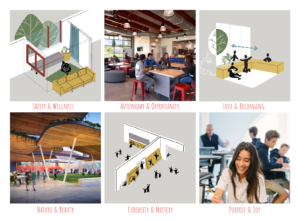AI in Education: Leading a Paradigm Shift
Key Points
-
At The Forest School, AI has been integrated since its inception to teach both AI development and usage, preparing learners for future challenges.
-
The integration of AI in education is not just a trend but a fundamental shift, akin to the transition from piston-engine to jet-engine aircraft, requiring careful consideration and ongoing reflection.

By: Dr. Tyler Thigpen
A buddy of mine, Paul, works for a major airline headquartered in Atlanta. The airline deploys him to examine new technologies. He assesses whether integrating them will improve plane flights and, if so, what the ripple effects are. Money, time, and lives are at stake. What a responsibility!
As an education leader, I feel a similar responsibility regarding new technology, though the stakes are different. Money and time, yes, but also morale, safety, and relevance.
These days, a massive tech integration question for teachers and school leaders is—What’s the right use of artificial intelligence (AI) in education?
My colleagues and I at The Forest School: An Acton Academy and The Forest School Online have integrated AI since our inception seven years ago. We believe understanding AI’s inner workings and using AI are both important. By teaching AI development to select learners and AI usage to all, we prepare our learners for the future. The greatest takeaway for us hasn’t been finding helpful tools. A bit of R&D testing in classrooms with pilot users reveals whether the tools positively impact learning and are perceived as effortless by stakeholders. Rather, our exploration of AI has been much more meta than that. It’s more fundamental, more paradigm shifting.
My buddy Paul explains that the shift from piston-engine to jet-engine aircraft in the 1940s and 1950s required one of the most comprehensive changes in airport infrastructure, air traffic control systems, and international aviation regulations. It also led to the development of new safety standards and innovations in aircraft design and engineering. It shifted the aviation landscape for the better.
How should AI shift the current paradigm for teaching and learning? And how shouldn’t it?
I teach the leadership track of the Intro to Teaching with AI course at the University of Pennsylvania Graduate School of Education (our application window closes at the end of July 2024). In that program, we wrestle with fundamental AI questions, explore emerging tools, walk through the unique components of a school model where AI could play a part, consider ripple effects on the infrastructure of learning, and appreciate the risks. We wonder about and plan for a new division of labor for teaching and learning—what’s AI’s job vs the teacher’s vs the student’s vs the parents and caregivers? Like with any big change, we riff on how to invite stakeholders to adjust to AI and eventually row in the same direction.
As an example, my team and I walked through 13 unique components of a school model and made (for now) the following moves:
1. Vision
We asked—How can AI help us achieve our school’s vision more effectively?
How we answered—Our school mission is each person who enters our doors will find a calling that will change the world. For us, AI is like any other new tech. It can be used for good or ill. Thus, we’ve sought and embraced AI to the extent it helps us guide stakeholders to reify their life’s purpose. Anything short of that bar doesn’t get our attention for long.
2. Curriculum
We asked—How can AI customize and adapt our curriculum to meet the diverse needs of our learners?
How we answered—We landed on responsive and adaptive learning programs like Khan Academy, Zearn Math, DuoLingo, Lexia Core 5, and Amira Learning (the world’s first AI teacher of reading). The latter tool didn’t replace 1-on-1 or small group reading instruction, but it increased our capacity 10x to facilitate personalized reading practice. Since then, 100% of our diverse community of learners experienced reading gains of one year or more. Overall, the AI learning programs are far from perfect. But they’ve allowed many students to learn deeply and at their own pace. When ChatGPT launched, I led our middle school in an “AI Quest.” For six weeks we played with new AI tools and riffed on possibilities. For a final Exhibition, the middle schoolers wowed parents, caregivers, and visitors by writing e-books with visuals, responding to emails, synthesizing research, discussing AI ethics, and more. The adults were blown away.
3. Pedagogy
We asked—How can AI enhance our instructional methods and support personalized learning?
How we answered—Three methods arose for us. First, self directed learning. We’ve always been about learner-led education. But adding AI tools to peer-to-peer learning and trial and error meant our learners were even more empowered to take charge of their learning. Second, we embraced AI-driven career counseling with YouScience. Enhanced with AI, YouScience analyzes learners’ skills, interests, and aptitudes to suggest potential career paths and colleges that align with their unique profiles. One hundred percent of our middle and high schoolers now use it. Third, we enhanced learner support systems through tools like speech-to-text, language translation, and personalized tutoring.
4. Assessment
We asked—How can AI-driven analytics provide deeper insights into learner performance?
How we answered—Three methods arose for us here as well. First, we leveraged the learning analytics embedded in the responsive and adaptive learning programs mentioned above. They analyze student performance data to identify strengths, weaknesses, and interests, helping guide learners toward discovering their passions and potential callings. Second, we had our middle and high schoolers take the College and Career Readiness Assessment Plus. This world-class test uses AI to assess learners’ quantitative reasoning, analytical thinking, writing effectiveness, and writing persuasiveness. Third, we brought back a form of oral exams (which we call Practicals) to ensure authenticity in assessments. Essentially, learners can use AI at various points throughout their learning journey, but ultimately, they must prove mastery of foundational learning objectives in foolproof ways—i.e., both with and without AI tools.
5. Schedules and Routines
We asked—How can AI optimize our schedules and routines to create a more efficient learning environment?
How we answered—There are loads of possibilities on this front. We’ve used various AI tools for dynamic grouping, educator allocation, automated scheduling, task prioritization, traffic flow analysis, and more. Asking AI to brainstorm use cases helps.
6. Roles, Development, and Management Model
We asked—How can AI streamline administrative tasks and support data-driven decision-making for staff?
How we answered—AI has played a role in job posting, creating and synthesizing performance reviews, and professional learning. Now, we look for candidates with experience using AI in teaching and learning. On the job, we provide professional development for staff to practice doing so. We guide educators through prompt-making exercises. We’ve made our own bots to aid internal planning and reflection processes.
7. Community Practices and School Culture
We asked—How can AI foster a more inclusive and connected school community?
How we answered—To get everyone on the same page, we appointed a small team to facilitate our educators, learners, parents, and caregivers across our organization to authorize guiding principles for AI use. The resulting principles reveal a dual commitment to encouraging AI use while maintaining a commitment to authentic, collaborative, iterative, and deep disciplinary learning.
8. Bridges and Partnerships
We asked—How can AI facilitate stronger partnerships with external organizations and stakeholders?
How we answered—We’re actively searching for partnerships to help us with enduring IP and privacy wonderings. We’re not alone in needing help here. Given recent failures in the sector (like the recent one in Los Angeles), there’s nervousness around partnerships.
9. Tech and Tech Infrastructure
We asked—What technological infrastructure do we need to support AI integration effectively?
How we answered—Over the last seven years, we’ve purchased 20+ subscriptions to AI-driven programs.
10. Continuous Learning and Improvement Mechanisms
We asked—How can AI support continuous professional development for our staff?
How we answered—To inform decision making, we’ve used AI bots to synthesize internal and external stakeholder feedback, helping identify themes across stakeholder groups.
11. Space and Facilities
We asked—How can AI enhance the use of our physical space and facilities for better learning outcomes?
How we answered—AI use demands dynamic space management and personalized learning environments. Recently we conducted this research about catering our space to individual learning styles and needs.
12. Budget, Operations, and Logistics
We asked—How can AI optimize our budget, operations, and logistics for greater efficiency?
How we answered—We’ve streamlined some routine administrative tasks like updating learner support documents and personalized learning plans), allowing our team to focus more on guiding learners and communicating with parents. Also, we amped up data-driven decision making (e.g., AI-driven predictive analytics to anticipate resource needs and manage budget allocations) to make better decisions based on data.
13. Communications
We asked—How can AI improve our communication with parents, students, and staff?
How we answered—Emails, emails, emails. Web copy. Newsletters. Job postings. Social media. Graphics. Did I mention emails?
In sum, AI has helped our schools by: providing personalized and interactive learning experiences, tailoring educational content to cater to different intelligences, scaffolding support that adjusts to learners’ current abilities, increasing administrative efficiencies, and aiding our team’s progression from teaching to guiding.
Integrating AI has potential pitfalls. It can increase screen time, make cheating more attractive, diminish human-centered relationships, and increase tech company influence in schools. Prioritizing efficiency might incentivize learner laziness, undermining productive struggle and creativity. It could exacerbate educational inequalities between better and lesser resourced schools. Environmental impacts from tech infrastructure needed for AI add further challenges. To mitigate these issues, some combination of promoting balanced AI usage, facilitating bona fide learning and evaluation processes, enhancing human connections, and focusing on equity and eco-friendly practices makes sense.
Despite possible drawbacks, an exciting wondering has been—What if AI was a tipping point helping us finally move away from a standardized, grade-locked, ranking-forced, batched-processing learning model based on the make believe idea of “the average man” to a learning model that meets every child where they are at and helps them grow from there?
I get that change is indescribably hard and there are risks. But the integration of AI in education isn’t a trend. It’s a paradigm shift that requires careful consideration, ongoing reflection, and a commitment to one’s core values. AI presents us with an opportunity—possibly an unprecedented one—to transform teaching and learning, making it more personalized, efficient, and impactful. How might we seize the opportunity boldly?
Dr. Tyler Thipen teaches Introduction to Teaching AI and Leading School Transformation at the University of Pennsylvania Graduate School of Education, and serves as CEO of The Forest School: An Acton Academy and Institute for Self Directed Learning in Trilith south of Atlanta, GA.







0 Comments
Leave a Comment
Your email address will not be published. All fields are required.